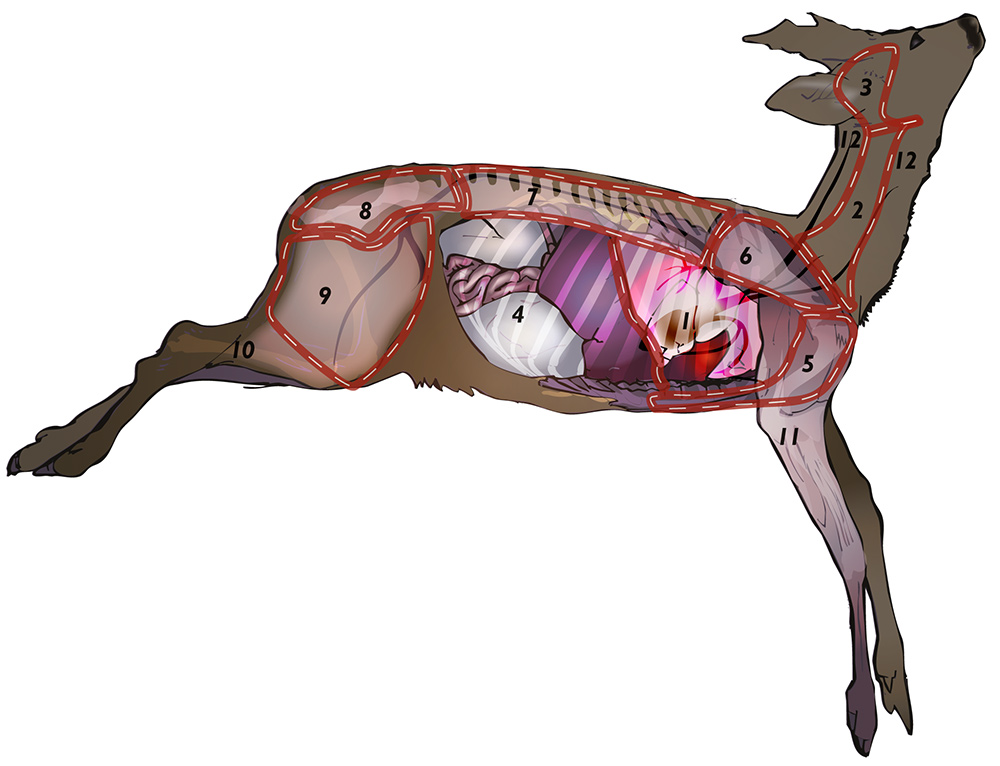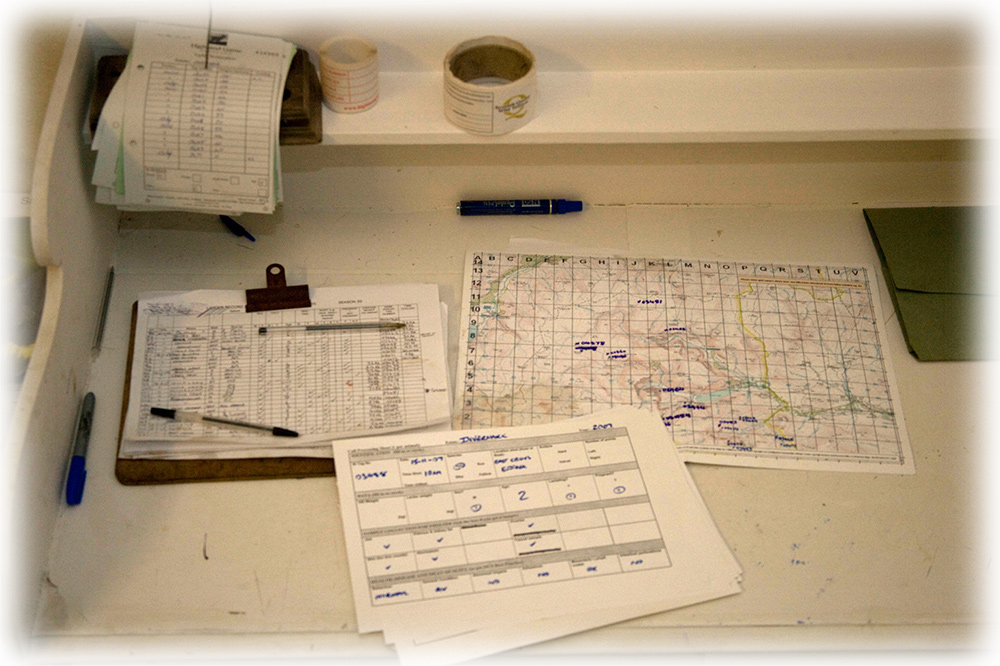Aim
This guide sets out cull records that are either required of or useful for those who take or kill deer. Specifically it identifies:
- Why records should be kept;
- What records are required by legislation;
- What records provide added value.

Bullet entry/exit codes : 1 Chest; 2 Neck (fatal); 3 Head (fatal); 4 Guts (abdomen;) 5 Brisket (sternum)*; 6 Shoulder (upper scapula)*; 7 Saddle (spinal vertebrae)*; 8 Upper haunch (pelvis)*; 9 Mid haunch*; 10 Back leg; 11 Front leg; 12 Outer neck and head (non-fatal) *; denotes areas of importance to venison quality.
Bullet entry/exit codes : 1 Chest; 2 Neck (fatal); 3 Head (fatal); 4 Guts (abdomen;) 5 Brisket (sternum)*; 6 Shoulder (upper scapula)*; 7 Saddle (spinal vertebrae)*; 8 Upper haunch (pelvis)*; 9 Mid haunch*; 10 Back leg; 11 Front leg; 12 Outer neck and head (non-fatal) *; denotes areas of importance to venison quality.
Reasons for Maintaining Cull Records
Data gathered from culled animals may be required to comply with legal requirements,![]() to assist with informing deer management
to assist with informing deer management ![]() and to meet standards required through quality meat assurance schemes or individual venison dealers
and to meet standards required through quality meat assurance schemes or individual venison dealers![]() .
.
| Scottish Natural Heritage: SNH (under Section 40 of the Deer (Scotland) Act 1996) may require owners/occupiers to submit records of deer taken or killed. The information required may include species, sex, whether in season or out and on what type of land* | ||
| Food Hygiene: Hygiene legislation requires that the health, condition and behaviour of deer destined for the food chain are checked and recorded and that the carcass can be traced back from the processor to where it was shot.** | ||
| Deer Management: Cull data collected may be used to inform and monitor management. It is recommended that those collecting the data are briefed on the results and management implications annually. | ||
| Quality Assurance: Quality assurance schemes or the additional food safety management requirements of venison processors may require that extra records be kept. |
Data to be recorded
Essential data:
If including additional information in the cull record you should be clear as to what it will be used for. Review the data collected on a regular basis to ensure that it is still relevant and is being used for the intended purpose.
 Carcass tag number/declaration number.
Carcass tag number/declaration number. Date shot. (Relates to food hygiene, body condition and reproductive status.)
Date shot. (Relates to food hygiene, body condition and reproductive status.) Species.
Species. Sex (M/F).
Sex (M/F). Location shot and 6 figure grid reference. (Essential for traceability as well as relating to the Deer Management Plan and cull targets.)
Location shot and 6 figure grid reference. (Essential for traceability as well as relating to the Deer Management Plan and cull targets.) Time culled (to nearest hour).
Time culled (to nearest hour). Abnormalities to organs such as the: mouth, tongue, lungs, bladder, kidneys, lymph nodes, adhesion between viscera and abdominal wall and any other part of the carcass.
Abnormalities to organs such as the: mouth, tongue, lungs, bladder, kidneys, lymph nodes, adhesion between viscera and abdominal wall and any other part of the carcass. Abnormal condition or behaviour observed before shooting.
Abnormal condition or behaviour observed before shooting. Carcass contamination.
Carcass contamination. Name of individual who signed inspection declaration.
Name of individual who signed inspection declaration. Butcher weight (gralloched with head, legs and pluck removed, dried) (Kg).
Butcher weight (gralloched with head, legs and pluck removed, dried) (Kg).
Data providing added value
 Name of the individual who culled the deer.
Name of the individual who culled the deer. Name of individual who gralloched the deer (if different from above).
Name of individual who gralloched the deer (if different from above). Age class (calf, young, middle, old). If age determination is important to the management objectives, lower jaws must be stored for an independent check at a later date.
Age class (calf, young, middle, old). If age determination is important to the management objectives, lower jaws must be stored for an independent check at a later date. Pregnant?
Pregnant?
Embryo: Y/N; Number present.
(Embryo presence/absence relates to reproductive status.)
Corpus Lutea: Y/N; Number present.
(Corpus Lutea indicate the number of eggs which have been released, but do not indicate fertilisation, implantation or pregnancy.) Milk in udder? (Y/N)
Milk in udder? (Y/N)
(Milk presence/absence can indicate a dependant calf which has welfare considerations.) Kidney fat cover (code e.g. 0 or 1). (Relates to condition.)
Kidney fat cover (code e.g. 0 or 1). (Relates to condition.) Bullet entry (code - see illustration above). (Relates to carcass value and welfare.)
Bullet entry (code - see illustration above). (Relates to carcass value and welfare.) Bullet exit (code - see illustration above).
Bullet exit (code - see illustration above). Hill weight (gralloched with head, legs and pluck attached) (Kg).
Hill weight (gralloched with head, legs and pluck attached) (Kg). Time into chiller.
Time into chiller. Air temperature of chiller (or larder if no chiller) (ºC).
Air temperature of chiller (or larder if no chiller) (ºC).
An example Deer Larder Record form can be found in the Reference section.

